
Related
“Walkout”–a new HBO film tells the story of the 1968 walkout by high school Chicano students in East Los Angeles to protest academic prejudice and dire school conditions. We speak with the executive director of the film, Moctesuma Esparza. An award-winning film producer and community activist, Esparza helped organize the 1968 walkout and was arrested and jailed along with 12 others for conspiracy to disturb the peace. [includes rush transcript]
The mass student walkouts this week across California and other states are not the first of their kind. In 1968, Chicano students in East Los Angeles staged a historic walkout in their high schools to protest academic prejudice and dire school conditions.
Students were forbidden from speaking Spanish in class or from using the restrooms during lunchtime. Schools taught a curriculum that largely ignored or denied Mexican-American history and Chicano students were steered toward menial labor and away from college by counselors and school officials.
In March 1968, the students decided to take a stand against the injustice and staged walkouts in schools across L.A. Many date the modern Chicano movement to the walkouts when some 20,000 teenagers took to the streets
Many of the students who participated in the walkouts went on to successful careers in politics, academia and the arts. One of them was Antonio Villaraigosa–he’s now the mayor of Los Angeles. Another was award-winning filmmaker Moctesuma Esparza, who was indicted for his role in organizing the walkouts. He is now executive producer of a new HBO film about the 1968 protests simply titled “Walkout.”
- “Walkout”–excerpt of HBO film.
- Click for more information
We are joined on the line by now by award-winning film producer and community activist, Moctesuma Esparza. He is the executive producer of “Walkout,” based on the historic 1968 student walkout in Los Angeles which he helped organize. Esparza and 12 others were arrested and jailed for conspiracy to disturb the peace. They became known as the East LA 13. Esparza is portrayed in the film by Bodie Olmos, son of the movie’s director, Edward James Olmos” son. And Esparza’s real-life daughter, Tonantzin Esparza, plays Vickie Castro, a protester who went on to become a principal and a school board member.
- Moctesuma Esparza
Transcript
JUAN GONZALEZ: Many of the students who participated in those walkouts went onto successful careers in politics, academia and the arts. One of them was Antonio Villaraigosa. He’s now the Mayor of Los Angeles. Another was award-winning filmmaker Moctesuma Esparza, who was indicted for his role in organizing the walkouts. He is now executive producer of a new HBO film about the 1968 protest, simply titled Walkout. This is an excerpt.
STUDENT: Walkout! Walkout, Garfield!
STUDENT: Roosevelt, walk out!
STUDENT: Wilson, walkout!
TEACHER: Paula, get back in your seat, please.
PAULA CRISOSTOMO: Walkout.
STUDENT: Walkout! Walkout!
STUDENT: Walkout!
CROWD: Chicano Power! Chicano Power!
REPORTER: Excuse me, aren’t you Sal Castro, the teacher who orchestrated today’s walkout?
SAL CASTRO: Yes, I am Sal Castro, and, no, I didn’t orchestrate the walkouts. The kids did it on their own.
REPORTER: Why do you think they did it?
SAL CASTRO: Well, the Mexican American community has long been referred to as the sleeping giant. And today, it’s getting its wake-up call.
CROWD: Chicano Power! Chicano Power!
AMY GOODMAN: An excerpt of the film, Walkout, courtesy of HBO. We’re joined on the line now by award-winning film producer and community activist, Moctesuma Esparza. He’s the executive producer of Walkout, based on the historic 1968 student walkout in Los Angeles, which he helped organize. Esparza and twelve others were arrested and jailed for conspiracy to disturb the peace. They became known as the East L.A. 13. Esparza is portrayed in the film by Bodie Olmos, son of the movie’s director, Edward James Olmos. And Esparza’s real-life daughter, Tonantzin Esparza, plays Vickie Castro, a protester who went on to become a principal and a school board member. Moctesuma Esparza joins us on the line from California, headed to Mexico today. We welcome you to Democracy Now!
MOCTESUMA ESPARZA: Good morning, Amy. It’s great to be with you.
AMY GOODMAN: It’s great to be with you, as well. So, you made this film. It airs this week. And the students — high school students like those you were with 38 years ago are walking out. What are your thoughts?
MOCTESUMA ESPARZA: I feel blessed to be associated with a powerful rebirth of social consciousness in my community. That’s how I feel.
JUAN GONZALEZ: Moctesuma, the impact of not only the student protests, but these massive demonstrations throughout the country of the Latino community responding to the debate and to the draconian proposals for immigration restriction.
MOCTESUMA ESPARZA: We made this movie to be an actual manual on how to organize, you know, what the risks are, what has to be thought of, and what could happen, and what needs to be done. And prior to its airing on March 18, from mid-February to the actual airdate, Eddie Olmos and I went on a over a 20-city tour where we presented this movie to over 15,000 people, who all just completely gave themselves to the movie and the experience of the movie and what the movie was talking about. And so, I’ve been getting back reports continually that many young people have seen this film and have been inspired by its message and are applying its tactics and strategies to the current situation.
AMY GOODMAN: Moctesuma Esparza, can you talk about how it happened in 1968, what role you played, how the students responded, and then how the police responded?
MOCTESUMA ESPARZA: Well, I had been organizing in East L.A. since 1965. I had been fortunate to attend a youth leadership conference, the Chicano Youth Leadership Conference at Camp Hess Kramer at Malibu, where Sal Castro had recruited me to go, and I had met students from the other high schools. And we portrayed this experience in the movie. And out of that, people from all of the high schools came together, and we organized a group called Young Citizens for Community Action. This was 1965. That group eventually changed its name into Young Chicanos for Community Action and then evolved into the Brown Berets and UMAS.
So, once I graduated from high school in 1967, and we had been trying to organize while I was still in school, all of us were — the membership was from all East L.A. schools — we continued organizing. I went to UCLA. I was a founder of UMAS there. There were twelve of us, Chicano students, that started the organization, and we made a commitment that we would go help organize the rest of the campuses. We had a huge conference that summer of 1967, in which college students — there were a couple of hundred — came together from throughout Southern California. It was basically almost everyone who was in college then, because there was less than 2% of all Chicanos that even enrolled in college.
And we then gave ourselves the assignments for each campus to mentor the high school students of a particular high school. Those high school students were already experiencing a growth in consciousness. This is 1967, while the Vietnam War is in full bore, and protests are growing, and the Civil Rights Movement is flourishing. And throughout the world, young people are looking to change the world. And this was not lost on the kids in East L.A. They were able to see what their own circumstances were and how they were being oppressed, how they were being denied an opportunity for an education, an opportunity to fulfill their lives. And so, it was not difficult to organize them.
They wanted to be organized. They wanted to do something, and so what we did at that point as college students was provide them context and assist them. And they made all of their decisions. It was an extremely democratic movement. The high school students were very jealous of their own prerogatives and of their own independence. And what we did as college students was to provide a safety net for them once they did decide to walk out, to act as monitors and as security for the movement, and providing resources and the community support system to then begin to reach out to parents and to labor movements and to the clergy. So we went on it very methodically. It took us a couple of years.
And what is going on now has happened — it looks and feels like it’s almost spontaneous. I do know that there was organizing that was going on, but it was much faster. And the results were just combustible. So what took us several years back in 1968 seems to have taken a couple of weeks here.
JUAN GONZALEZ: Jose Luis Rodriguez, I’d like to ask you about this accelerated development of this movement. There’s a new element here, it seems to me, which is the role of the media, not so much the English-language corporate media, but the Spanish-language media. As I understand it, a lot of the Spanish-language radio disc jockeys were actively promoting the various protests around immigration, even many of the Spanish-language Univision personalities put out a public service ad for the big Saturday march in L.A., urging people to attend. So there was a real sort of split in the media as the Spanish-language — while the English-language media paid almost no attention or criticized these protests, the Spanish-language media, in effect, helped to promote it.
LUIS RODRIGUEZ: Absolutely. Actually, rival disc jockeys got together and decided that they would participate. They actually talked on air. These were rival stations that probably were competing, you know. But now they’re saying, ’Let’s get people organized, let’s get them together.’ So it was very massive, the mobilization. The other things, you had cell phones, you have blueberries, you have myspace.com. You have a lot of ways that young people are communicating that didn’t happen in 1968 the way that it is now. Of course, I was also involved in 1968, and I remember my walking out. And when I was a senior, I ended up leading three walkouts. And by then, Paula Crisostomo, who is featured in the Walkout film, was one of the leaders. She actually worked at [inaudible] High School when I was there. So I also developed that work and got the leadership training.
But I do agree with Moctesuma, it took a lot longer. And to see the mobilization now is really amazing to me, but it’s also important that young people are already conscience and coherent about what the issues are. I think all it took was people to say ’Let’s mobilize, let’s get organized, let’s get these things moving.’ And the leadership, I think, is getting to the point where it’s engendering new leadership. Young people themselves are gaining the leadership that took a few years in the past. Now it’s happening much more quickly.
AMY GOODMAN: Jasmine, did you see this movie, Walkout?
JASMINE CHAVEZ: Actually, I went to the conference this weekend, and I saw it at the CYLC. They showed us a documentary, and I did see it.
AMY GOODMAN: And what did you think?
JASMINE CHAVEZ: It was beautiful. Beautiful in the fact of how much power — a lot of students — well, at least at my school and I have spoken to — have seen it. And that, to me, I’m hoping motivates them to see that if you were put on lockdown, that shows how much power the students have. If they had to put you on lockdown and you still were willing, and they couldn’t stop you to walk out, to me that was very powerful.
AMY GOODMAN: Moctesuma Esparza, I wanted to ask, one of the poignant parts of this film is the student saying, after the video footage and seeing lots of photographers there documenting police brutality against the high school kids, they felt this would be a turning point. And then they turned on their televisions, and they looked at the papers, and they didn’t see any of those images. Can you talk about the coverage in 1968?
MOCTESUMA ESPARZA: The coverage was extraordinarily censored, on a corporate level following the lead of the district attorney and the mayor and the power structure. They self-censored. It was astonishing to me. I mean, looking back on it, the fact that CBS and NBC and all of these corporate stations that had tremendous news coverage capability and were there, and all of these photographers that were there for the L.A. Times and the Herald, they did not publish or show or comment on the police violence. And the police violence was extreme. I mean, it makes Rodney King look like a picnic, really, because Rodney King was a gentleman who was evading arrest. And, you know, what was done to him was brutal and awful, but the police there, you know, had at least some modicum of provocation. These were high school kids who were peacefully protesting for their rights. They were children. And they were brutalized.
There are blows that were recorded on film that were like death blows. It was really, really awful. And when that footage was finally discovered in 1995, when the research was being done for the PBS documentary Chicano, it was astonishing to us that that footage had survived and even existed. It was vital, because it gave us the ability to show HBO that what we were re-creating was absolutely accurate and real. And it was necessary, because HBO wanted to make sure that what we did was real. And we had to go through very careful steps to authenticate everything that we portrayed in the movie. And I want to thank HBO, because no other studio would have let us make movie. It is an astonishing event that this movie got made at all.
JUAN GONZALEZ: And, Moctesuma Esparza, looking back over those 38 years, especially at all of the current day Chicano leaders that really emerged from that struggle, not only yourself, Jose Luis Rodriguez, Antonio Villaraigosa, Gil Cedillo, the state senator from L.A., so many of the current leaders of the Latino community in Southern California, the lessons you draw about how leadership is forged and emerges.
MOCTESUMA ESPARZA: Well, certainly, I think that we’re being blessed right now, because the young people who are participating realize that they can do this and survive, that their bravery has a payoff, and that they can continue throughout their lives to be activists, which is one of the things that has occurred. The people who were involved as part of the leadership of 1968, and who continued their younger brothers and sisters, because there were walkouts all the way to 1972, 1974, on a fairly regular basis, all of them have a social conscience that continues to this day. All of them are making contributions in one way or another in whatever walk of life they’ve chosen. And we show that in the movie by interviewing and giving short clips to some of the leaders of the walkouts who were regular kids and who today are continuing to be activists in their particular profession.
JASMINE CHAVEZ: Moctesuma, I wanted to end with Jasmine in the studio in Los Angeles. One of the students who has walked out. Los Angeles Unified School District Chief Roy Romer warns students, starting today, that you will be treated as truants if you don’t turn up for class or if you walk out. What’s your response to this, Jasmine?
JASMINE CHAVEZ: Well, actually, we’re organizing for a walkout on Friday. We’re going to walk out on Cesar Chavez’s birthday. And we’re mobilizing. We’re going to have teach-ins. Thanks to CYLC, the Chicano Youth Leadership Conference, I met up with more than 20 schools. I’ve gotten their numbers. We’re organizing. We’re going to have one representative from each school go to somebody’s house and do this in a calm, peaceful way. And despite the consequences, we’re still going to do this, because we have a voice, and we’re not afraid to use it.
LUIS RODRIGUEZ: And let me just add, this is education.
JASMINE CHAVEZ: Yes, it is.
LUIS RODRIGUEZ: This is also learning. This is also the way people learn who they are, what they should be. And some of these leaders will be the future Moctesumas, they’ll be the future leaders, they’ll be the future mayors of these cities.
AMY GOODMAN: On that note, I want to thank you all for being with us. Luis Rodriguez, Jasmine Chavez, high school student, one of those walking out, and finally, we want to thank Moctesuma Esparza, award-winning film producer.

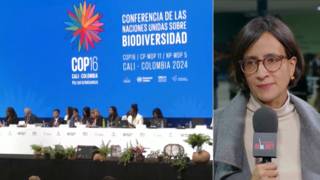
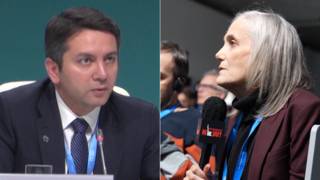
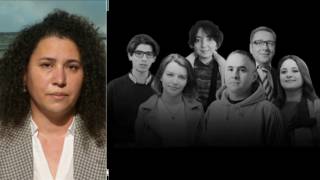
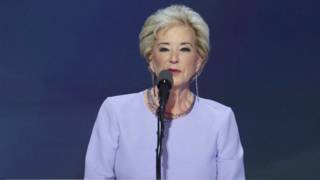





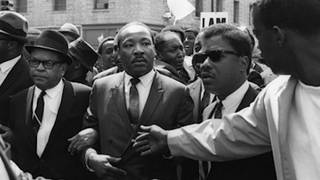
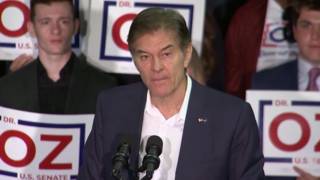
Media Options